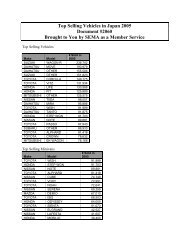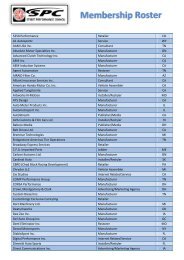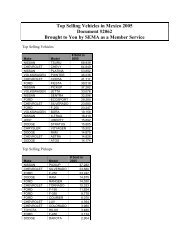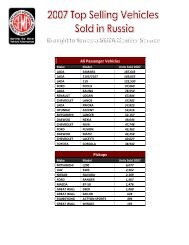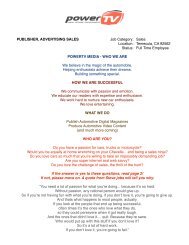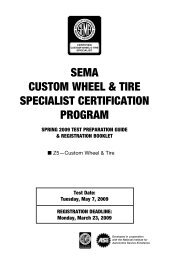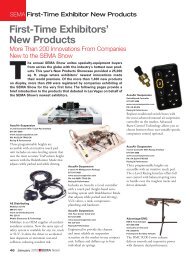Show Daily - Sema
Show Daily - Sema
Show Daily - Sema
Create successful ePaper yourself
Turn your PDF publications into a flip-book with our unique Google optimized e-Paper software.
Nitto Has Busy GTE/SEMA Week Planned<br />
Celebrating the company’s two million<br />
Facebook ‘Likes,’ Nitto Tire USA<br />
Inc. welcomed friends and industry<br />
professionals to their Global Tire Expo/<br />
SEMA <strong>Show</strong> booth #43183 Tuesday.<br />
Electronic dance music DJ and<br />
producer Steve Aoki was present to<br />
announce a lucky prize winner for<br />
Nitto’s “Birthday Bash Sweepstakes,”<br />
a promotion run on Facebook. Nitto<br />
will fly a total of five lucky fans to<br />
Los Angeles later this month to attend<br />
Steve Aoki’s Birthday Bash Fueled by<br />
Nitto. One grand prize recipient will<br />
also get time behind the wheel burning<br />
some Nitto rubber with drifting<br />
Many Options Available in Direct TPMS Sensors<br />
Without a doubt, the key to successfully<br />
servicing direct TPMS is proper<br />
training not only for technicians, but<br />
for service managers as well.<br />
Exceptional knowledge at the service<br />
counter not only helps to determine<br />
a customer’s needs, but it also helps<br />
to educate those customers unfamiliar<br />
with TPMS. After all, how many drivers<br />
actually read the owner’s manual<br />
tucked away in the glove box?<br />
In an effort to reduce tire-related<br />
problems and accidents due to underinflation,<br />
TPMS became mandatory<br />
for all light motor vehicles sold in the<br />
United States after September 1, 2007.<br />
The Tire Industry Association (TIA)<br />
has done a sensational job in helping<br />
to educate the tire industry by providing<br />
training and educational materials<br />
regarding proper TPMS service. TIA<br />
offers training kits that can be purchased<br />
online, as well as TPMS-related<br />
charts and manuals to make servicing<br />
and customer education easier.<br />
But with all of TIA’s effort to help<br />
the tire-service industry, the majority<br />
of consumers still lack the knowledge<br />
of tire-pressure monitoring systems<br />
(TPMS) and its safety benefits.<br />
There are many options available<br />
that are helping to drive down the<br />
hardware cost for direct TPMS. As<br />
TPMS continues to mature, the pricing<br />
is expected to head down due to<br />
progression in manufacturing technology<br />
and market saturation.<br />
But not all sensors are equal. Aftermarket<br />
sensors have worked well for<br />
domestic vehicles, but techs turn to<br />
OE sensors for the import vehicles.<br />
Roughly 35% of the aftermarket sensors<br />
installed on BMW and Mercedes-<br />
Benz vehicles by some shops were<br />
coming back for TPMS malfunctions.<br />
lessons from Formula Drift driver<br />
Matt Powers.<br />
Attendees enjoyed slices of an enormous<br />
cake built atop a Nitto tire while<br />
Aoki signed autographs. A video commemorating<br />
the company’s history and<br />
fan growth on Facebook played amongst<br />
the booth alongside featured show cars.<br />
An Audi R8 v10, BMW 550i, Off Road<br />
Evolution Jeep and Steeda Mustang all<br />
equipped with tires from Nitto’s wideranging<br />
truck, passenger and competition<br />
lines were present.<br />
Nitto Tire USA is proud to achieve<br />
the support and community of their<br />
two million Facebook fans. Nitto’s<br />
Eliminating comebacks is important<br />
in satisfying the customer and proving<br />
that your shop is up to speed when<br />
dealing with TPMS. It’s bad enough<br />
that the customer gets hit with additional<br />
costs, and comebacks only add<br />
insult to injury.<br />
There are some cases when a direct<br />
TPMS sensor fails prematurely—more<br />
specifically, when the valve core is<br />
discovered to be seized at the time of<br />
service. Techs generally see seized valve<br />
cores when either a valve cap is missing<br />
or a non-sealing valve cap is used.<br />
Most people don’t realize the tech that<br />
goes into something as simple as a valve<br />
cap, and that TPMS sensors require<br />
a specific type of valve cap. Using the<br />
proper $.15 valve cap can prevent further<br />
problems down the road.<br />
active Facebook page includes<br />
regular content updates as well<br />
as multiple customization features<br />
and apps, such as the<br />
Nitto Tire Selector and<br />
Tire Recommender.<br />
Nitto’s all-season tire technology,<br />
which promotes<br />
active outdoor driving in dry,<br />
wet and wintery conditions,<br />
has helped fuel their enthusiast<br />
following. Among these allseason<br />
technologies are advanced<br />
tread sipes, which are available<br />
on several Nitto styles, including<br />
Nitto’s latest offering Motivo.<br />
Another more common reason for<br />
valve core seizure is the use of brass<br />
cores instead of nickel-plated versions.<br />
Even with the use of sealing valve caps,<br />
brass cores will seize inside the aluminum<br />
TPMS clamp-in valve because of<br />
galvanic corrosion, a condition when<br />
dissimilar metals fail to coexist.<br />
Teaching Customers<br />
The intent of TPMS is to prevent<br />
underinflated tire conditions. Yet<br />
because of the cost to repair direct<br />
TPMS sensors, vehicle owners sometimes<br />
choose to ignore the warning<br />
light in the dashboard.<br />
“We have customers roll up to the<br />
door when their tire-pressure warning<br />
light comes on,” says one tire<br />
dealer. “Many times it is just low tire<br />
pressure. But when the customer realizes<br />
they need a sensor replaced after<br />
we diagnose their car, they sometimes<br />
just drive away, ignoring the warning<br />
light altogether.”<br />
This unintended consequence basically<br />
renders the TPMS ineffective.<br />
Letting the customer drive off with<br />
an inoperative system does not violate<br />
the Motor Vehicle Safety Act, since<br />
the system was presented to the service<br />
shop as inoperative.<br />
“If a customer comes in with a<br />
TPMS warning light and a sensor is<br />
diagnosed to have malfunctioned, we<br />
then try to replace the sensor,” says the<br />
dealer. “If we are unable to obtain a<br />
sensor quickly and the customer needs<br />
their vehicle back, we either re-use the<br />
old sensor or a conventional rubber<br />
snap-in valve as an emergency.”<br />
Again, this practice does not violate<br />
the “make inoperative” provision,<br />
since the vehicle was documented to<br />
have an inoperative sensor prior to<br />
TPMS service.<br />
With the proliferation of rubber<br />
snap-in valves used with direct TPMS<br />
sensors as a lower cost alternative to<br />
clamp-in TPMS valves at the OE<br />
level, confusion as to whether or not<br />
an assembly has a sensor can occur.<br />
Although snap-in TPMS valves have<br />
the distinguishing long shoulder and<br />
extended valve cap, there are chances<br />
of error to the untrained eye.<br />
“Proper training can prevent mishaps;<br />
we train all of our techs to<br />
treat every tire as if it has a direct<br />
TPMS sensor,” that dealer offered.<br />
The valve companies are working on<br />
introducing other means to make<br />
the snap-in TPMS valves more distinguishable,<br />
especially in poorly lit<br />
shop environments.<br />
#SEMA<strong>Show</strong> |<br />
SEMA <strong>Show</strong> <strong>Daily</strong> 69



